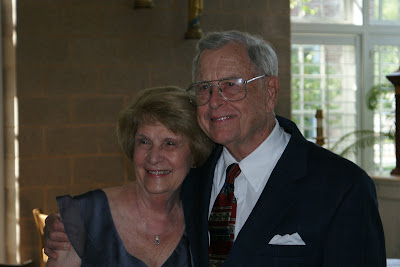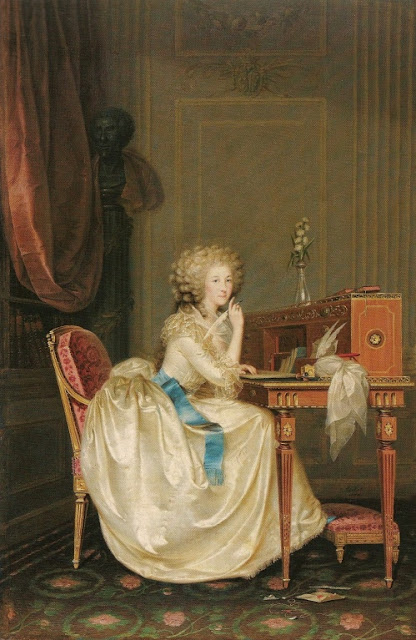The Door
Every time I've visited Marie Antoinette's bedchamber in Versailles, I've stared through this open door, so significant, yet so inauspicious, and tried to imagine what lies beyond.
Elissa, two of her friends, and I went to Versailles last week. We had a semi-private (maybe fifteen people tops) tour of the closed apartments of the King's and the Mesdames' and, later, a private tour of Marie Antoinette's rooms. Not just Marie Antoinette's rooms. I mean the ones that lie beyond this door, the ones that aren't open to the public, the rooms in which she spent her private hours. And, intriguingly, the hallway through which she fled as the mob, intent on harming her, broke through the protective barrier formed by her guards.
The significance of this door, in a nutshell, is that on October 5, 1789, the market women of Paris joined together, armed themselves with whatever was at hand, and walked to Versailles to confront Louis XVI. They wanted bread/food, wanted to vent their resentment for the system in which they were at a distinct disadvantage. They were fueled by hunger (and some, by wine) and inspired by revolutionary spirit. There were reports that the women were incited by, paid by, joined by disenfranchised aristocrats, women and men dressed as females. Some historians believe that the duc d'Orleans, the King's first cousin, had a hand in the planning of the march.
The story goes like this: Marie Antoinette was in the Grotto that she'd created as part of her back-to-nature pretend farm and village. She was relaxing, she was worrying, she was daydreaming? As it was within a few months of the storming of the Bastille; worrying would make sense. A page galloped up to deliver a note from the Comte de Saint-Priest telling her that a mob of women was approaching Versailles.
The Grotto - a man-made outcropping of rocks and stones forming alcoves and areas to sit, a small bridge that's within walking distance of Versailles and steps from the Petit Trianon.
The next twenty-four hours are well-documented. Louis XVI struggled to decide how to handle the crisis amid conflicting advice from all sides.
Family Under Seige, by Gyula Benczur (from nobility.org)
At one point, horses and carriages were readied, as he considered moving to a more hospitable, less accessible location, but the crowd cut the harnesses eliminating that option. Some extended members of the Royal Family and many courtiers, including close friend Yolande de Polinac, escaped that night, in disguise. The evening was tense as the Queen appeared on the balcony in front of the crowd who, fickle as mobs can be, jeered and threatened and, occasionally, cheered her. As the crowd camped in the gardens and courtyards of Versailles, Lafayette assured the King and Queen that the situation was in hand and, gradually, the Royal Family tried to get some sleep.
Madame Campan
Many years later, Madame Campan, the Queen's First Lady of the Bedchamber, wrote an account of what happened next that explains why that door has had such a place in my imagination.
“I was not in attendance on the Queen at this time. M. Campan remained with her till two in the morning. As he was leaving her she condescendingly, and with infinite kindness, desired him to make me easy as to the dangers of the moment, and to repeat to me M. de La Fayette's own words, which he had just used on soliciting the royal family to retire to bed, undertaking to answer for his army. The Queen went to bed at two in the morning, and even slept, tired out with the events of so distressing a day. She had ordered her two women to bed, imagining there was nothing to dread, at least for that night; but the unfortunate Princess was indebted for her life to that feeling of attachment which prevented their obeying her. My sister, who was one of the ladies in question, informed me next day of all that I am about to relate...."
On leaving the Queen's bedchamber, these ladies called their femmes de chambre, and all four remained sitting together against her Majesty's bedroom door. About half-past four in the morning they heard horrible yells and discharges of firearms; one ran to the Queen to awaken her and get her out of bed; my sister flew to the place from which the tumult seemed to proceed; she opened the door of the antechamber which leads to the great guard-room, and beheld one of the Body Guard holding his musket across the door, and attacked by a mob, who were striking at him; his face was covered with blood; he turned round and exclaimed: "Save the Queen, madame; they are come to assassinate her!" She hastily shut the door upon the unfortunate victim of duty, fastened it with the great bolt, and took the same precaution on leaving the next room. On reaching the Queen's chamber she cried out to her, "Get up, Madame! Don't stay to dress yourself; fly to the King's apartment!" The terrified Queen threw herself out of bed; they put a petticoat upon her without tying it, and the two ladies conducted her towards the oile-de-boeuf. A door, which led from the Queen's dressing-room to that apartment, had never before been fastened but on her side. What a dreadful moment! It was found to be secured on the other side. They knocked repeatedly with all their strength; a servant of one of the King's valets de chambre came and opened it; the Queen entered the King's chamber, but he was not there. Alarmed for the Queen's life, he had gone down the staircases and through the corridors under the oeil-de-boeuf, by means of which he was accustomed to go to the Queen's apartments without being under the necessity of crossing that room. He entered her Majesty's room and found no one there but some Body Guards, who had taken refuge in it. The King, unwilling to expose their lives, told them to wait a few minutes, and afterwards sent to desire them to go to the oeil-de-boeuf. Madame de Tourzel, at that time governess of the children of France, had just taken Madame and the Dauphin to the King's apartments. The Queen saw her children again. The reader must imagine this scene of tenderness and despair.”
Excerpt From: Jeanne Louise Henriette Campan. “Memoirs of the Court of Marie Antoinette, Queen of France, Complete.” iBooks. https://itunes.apple.com/WebObjects/MZStore.woa/wa/viewBook?id=361565168
View from the door, to the left of the bed if you're facing it, through which Marie Antoinette fled from her official bedchamber, through hallways of her private rooms, to the King's rooms. I've been on the opposite side of the gilded rail, but have never seen anyone in the doorway as these tourists saw us. I can tell you right now, I'd have been so damn jealous if I had. Also, small footnote, I've met and am fb friends with - practically best friends, right? - one of the people (or maybe he did it alone) that restored the gilding on the rail between the Queen's bed and the tourists. Elissa the Indomitable beguiled him from his restoration studio at Versailles to come down and meet us in the courtyard and take us on a private back room tour of the chapel last year.
Marie Antoinette's private rooms were both pretty and pretty small. I'll post pictures of them later.
This is what Marie Antoinette saw as she escaped with her life in the pre-dawn hours of October 6, 1789. In that year, these dim hallways and the inner rooms to which they led, would've only been illuminated by torches and candles.
Because of the level/angle of the top of the door leaving her official bedchamber, the beautiful carved arch above the next door isn't visible to tourists in the bedchamber, but, as you can see, it's lovely.
The next morning, the crowd insisted that the Royal Family go with them to Paris where they moved into the Tuileries and the noose began to tighten.
Count Axel Fersen, never one to run from the scene, was at Versailles that night and, when the decision was finally made to go to Paris, as the crowd demanded, he did so, as well. He described to his father, in a letter, afterwards, that two thousand carriages, filled with people and belongings, lined the roads as courtiers abandoned Versailles, never to return. I don't have the book of letters with me nor time to see if it's online to fact check, but I think that's the number he gave.
By the way, Amazon has practically every related book and memoir, and many memoirs are available online free.












Comments
http://www.amisdeversailles.com/
Last year, my friend and I did a private tour of the partially restored, closed rooms in the Petit Trianon (including those of the Lamballe - I was spellbound!) and, also, MA's theatre near the Petit Trianon. We even explored the stage and backstage. Some of those pictures are on my blog, too. We saw several really interesting, unexpected things on those tours, too. I need to go back through posts to label them, so they're more easily found...